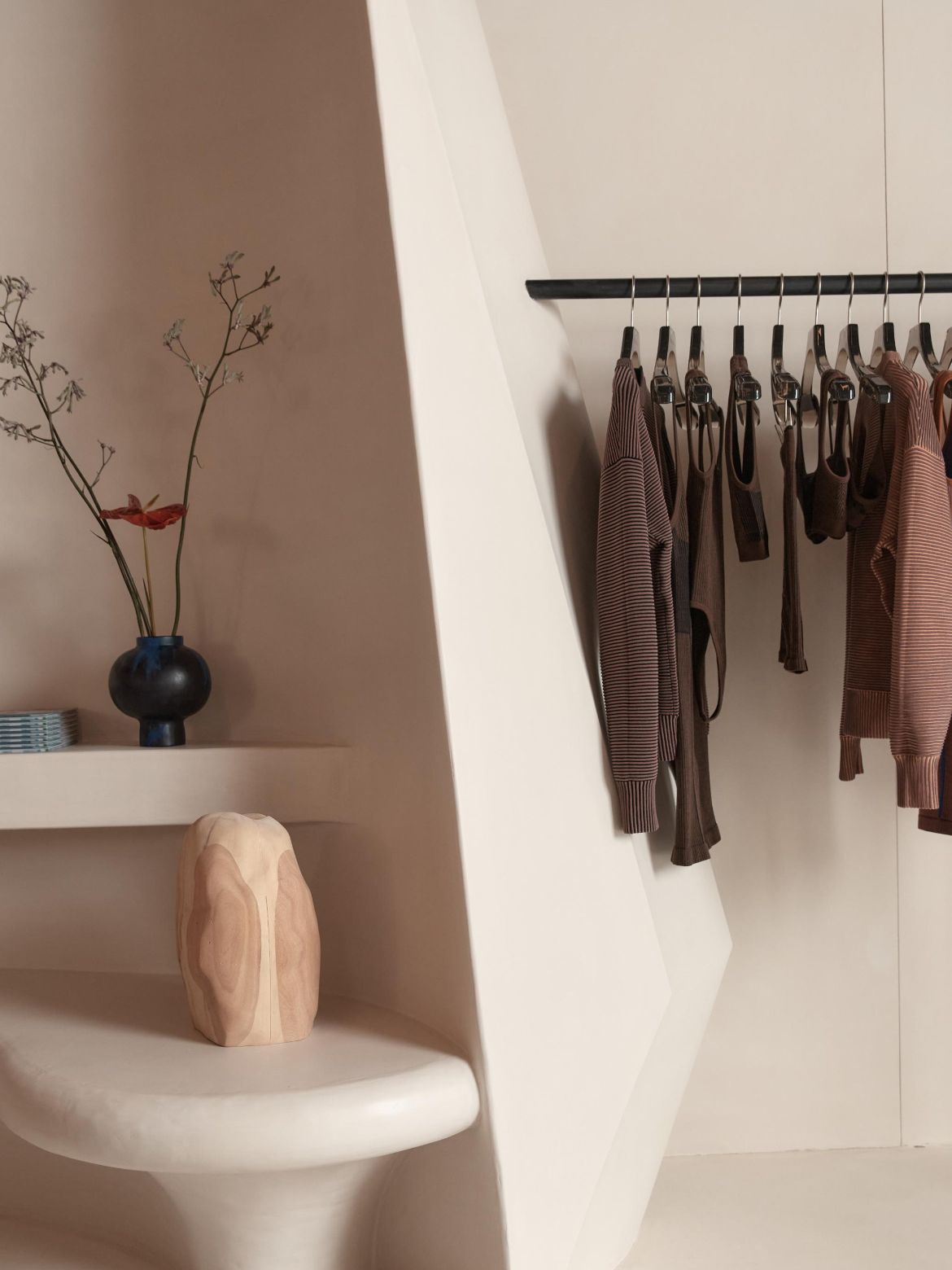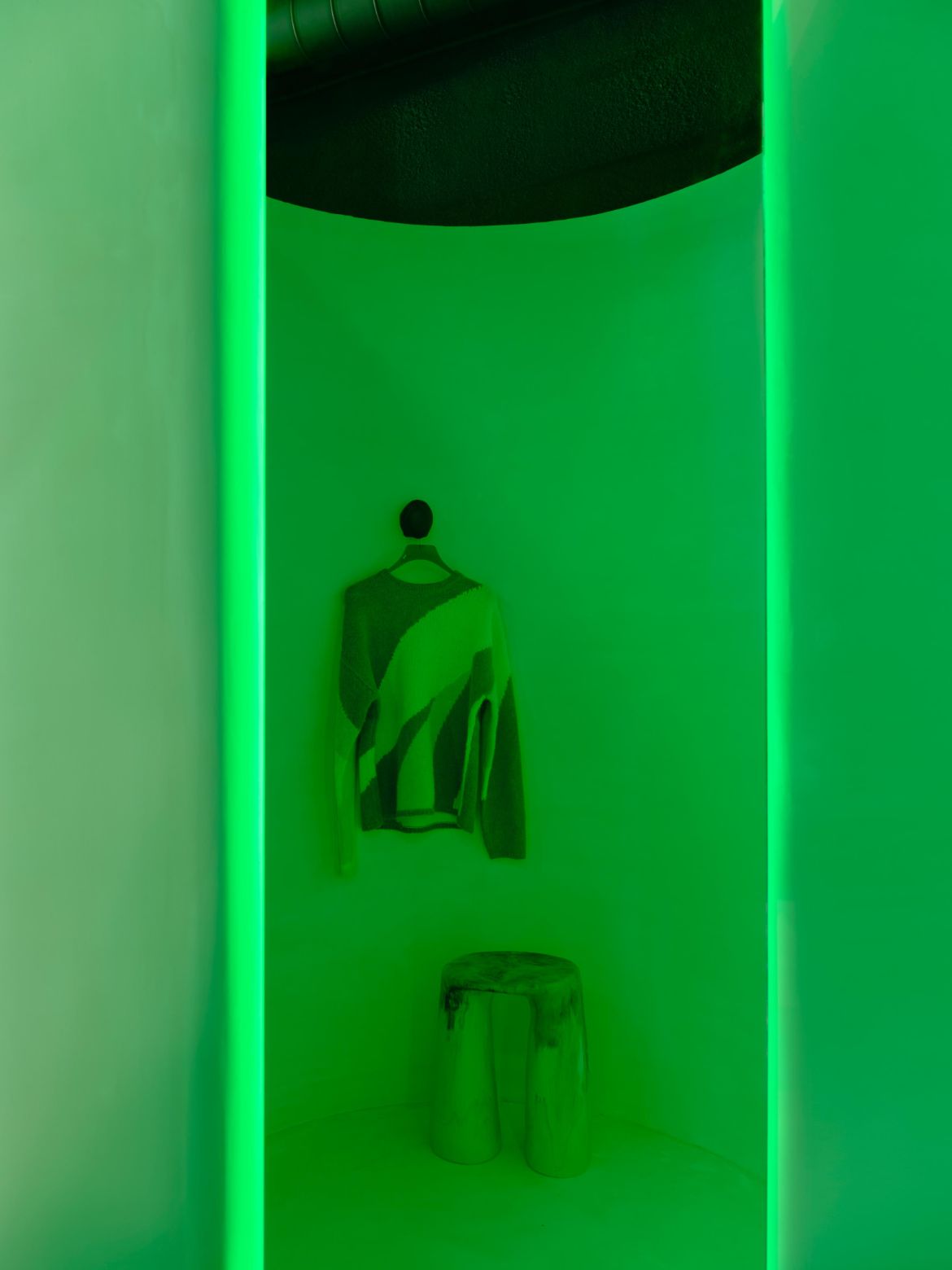Untenable and ephemeral trends dominate our social and media coverage, pressuring us to think, act and design a certain way; the overarching theme of sustainability is no exception. This espousal of environmentally friendly practices encourages our world to create and consider our actions towards our planet and invest (both literally and metaphorically) our time, attention and trade into businesses considering a brighter future.
Laura May founded the sustainable-minded design label, Nagnata, with a vision to contribute to a more sustainable business model within the fashion industry. In our conversation, we spoke to May about the driving philosophy behind her practice, the meaning of ‘home’ and the Nagnata Byron Bay flagship designed by Pattern Studio.

Habitus Living: Tell us about yourself, your background and what led you to where you are now.
I’m the Founder and Creative Director of Nagnata, an Australian fashion and lifestyle brand.
My background is in fashion and the arts, having designed and worked for various brands before founding my label. Raised in Sydney, I embarked on my fashion journey by studying fashion design at school and after only a year at TAFE, I was offered my first job when I was 19 years old. I started in the production room at iconic designer of the time, Leona Edmiston, where I would go between the fabric cutters and makers with patterns and toiles and do everything that was needed to bring a garment to life. During this time, Sydney had a vibrant local fashion scene. However, as the industry evolved, production gradually shifted offshore and my role evolved accordingly, finding myself travelling to Hong Kong and China to liaise with factories instead of navigating the bustling inner-city streets of Sydney.
Beyond design, I ventured into modelling during my youth, providing me with invaluable experience behind the camera which later enhanced my skills in directing and styling photoshoots. I was often asked to be the fit model for designers, which taught me about how to tailor and fit a garment to the body. In my early twenties, I then had the opportunity to intern overseas for designers while pursuing studies at leading creative colleges, Central Saint Martins in London and Istituto Marangoni in Paris, during the summers.

After returning home from a trip to New York, I was offered a job as a creative consultant. At the time, I wasn’t familiar with terms like ‘tastemaker’ or ‘trend forecaster,’ let alone that such roles could exist as a profession. It was an eye-opening experience to be paid for travelling the world and sourcing vintage garments and textiles to inspire designers for their collections. This journey eventually led me to the position of Head Designer at just 24 years old. Since then, my career has revolved around designing collections for various brands and designers until I embarked on creating my label.
I realised that one of my artistic strengths lies in my capacity to draw inspiration from the world around me. Whether it’s experiences, cultural influences, art or textiles, weaving these diverse elements together to articulate a personal perspective or a fresh aesthetic is something that comes naturally to me.
Tell us about your work – what is the driving philosophy behind what you do?
As Creative Director at Nagnata, my work involves directing our brand towards what I hope is a new blueprint for fashion and using our influence as a business to make a positive impact in the world. I’m interested in bridging the gap between art and activism, fashion and fairness, beauty and purpose, which has been my intention since founding Nagnata. The original business plan was shaped around a ‘slow fashion’ blueprint, Movements Not Seasons, and in some ways applied to my practice of yogic disciplines – led by a focus on mindfulness with a considered approach to design and the environment.
Our design process at Nagnata is guided by a focus on textile and knitwear innovation working with natural, renewable and organic fibres to create new fabrications that offer alternatives to high-content synthetic sportswear garments.
The name Nagnata, traditionally pronounced /nug-nuh-taa/ is derived from classical Sanskrit language and alludes to ‘nakedness,’ which is one’s most authentic state of being. This sense of purity and authenticity is woven through our Nagnata brand philosophy and ethos, from purity of fibre to our intention for transparency and commitment to positively cultivate and contribute to our community.
Related: Fashion and architecture collide in the newest collection by Farage

Can you share some insight into your creative process – when are you most in the zone?
I find creativity is a way of being. We can all be creative but some of us cultivate it more than others. My routine of personal practices is important to help me remain both connected to myself and sensitive and open to the world around me. On the Nagnata retreat I hosted recently, we worked with our bodies using practices of yoga, breath work, sound and dance to clear energetic blockages and allow for the flow of ‘prana’ or ‘chi’ energy, enabling deeper access to our life-force energy for healing – and the cultivation of our creative energy.
If my energy is flowing well then generally my creativity is too, as everything is energy!
Travel has also been a huge source of inspiration in my life. As I experience new cultures and places, I notice what speaks to me and draws me in, and I respond from that place of intrigue. I often dream up creative concepts when I am alone, and now that I have a team around me I will go to the studio and collaborate to bring them to life. I do love the process of creative collaboration as it allows you to deeply explore your ideas with others and often takes it somewhere new.

How does design play a role in your life?
Design is the way in which I interpret the world around me and express my point of view. It’s my form of communication, exploring every day how diverse design can be as a medium. The storytelling of a collection can go beyond the clothes, from the fibre to the textile to the artisans and the makers. I enjoy taking people on a creative journey, whether it’s through captivating campaign shoots, runway shows, short films or experiential presentations. Collaborating with other artists is equally inspiring, as it allows our worlds to intersect and new ideas to merge.
What does home mean to you?
Home to me is something deeply personal you create for yourself. For a long time, home was something I found in many different places as I found it challenging to settle in one place. I could adapt and make a home wherever I was at that time, which worked for me as I loved to travel and that was my priority. When I landed in Byron Bay on Bundjalung Country ten years ago, I felt a deep sense of coming home. It’s been a journey to settle here, build a business and a home. Now home is my place to rest, retreat, nurture and create.

How does your home reflect your passions, interests and creativity?
My home is a small place by the beach with a beautiful 100-year-old Poinciana tree protecting us from the road. When I bought the house a few years ago I embarked on the renovation and (naively) stripped it back to its shell to redesign. A scrapbook of interior influences was my guide – it was a very intrinsic journey and DIY process with my builder, who thankfully is also my friend and had a lot of patience with me on this project.
Inspired by the adobe desert houses I’d seen in New Mexico, I rendered the home while infusing hints of Japanese wabi-sabi. To reflect our lifestyle, I kept a Byron surf-shack feel, complemented by my boyfriend’s collection of surfboards adorning various corners and resting on the ceiling wooden beams. We love collecting books so they are scattered around the house, with records and a lot of clothes everywhere! All of the timber in the home is recycled and we painstakingly hand-sourced each piece from the timber yard in Byron.
Bathing is an important ritual for me, which is why I’ve made the bathroom a focal point of my home. Featuring a stunning high timber roof and skylight, complemented by stone floors and rendered walls, the bathroom exudes a sense of natural elegance.
Outside, the goal was to create a serene oasis with a stone bath alongside the sauna, offering a tranquil setting for holistic rituals that I love indulging in by myself or with friends; whether it’s a soak under the stars or hot/cold therapy sessions, it’s a space where I cherish moments of self-care.

Tell us about the design process behind the Nagnata Byron Bay flagship – how did Pattern Studio create the in-store experience you wanted?
Collaborating with Pattern Studio to create a physical world for Nagnata was an immensely rewarding experience. It allowed us to delve deeper into our brand’s identity and visualise how that essence could manifest in the design of our space. Through this partnership, we were able to bring our brand vision to life in a tangible and immersive way, shaping not just a physical environment, but an extension of our brand ethos.
The store’s design is anchored in a refinement of materials sourced from the natural world, with elements of nature creating a sense of harmonious balance and serenity. Worldly influences inspired by our travels synergistically blend with architectural elements.
The collaborative process began with my hand-drawn sketches, moodboards and an amalgamation of ideas and influences that I presented to Josh and Lily at Pattern. We were working with a blank canvas and essentially had a cement room to uniquely customise every detail. Pattern Studio meticulously crafted refined concepts, and once we aligned on the direction, they diligently drew and rendered every detail to assist with the sourcing of materials. Their inclusive and patient approach was invaluable, especially considering it was Nagnata’s first retail space.
One feature that allows the feeling in-store to evolve is that we offset the raw elements with LED linear lighting that can instantly bathe the entire space in a wash of coloured light. This transforms our serene sanctuary into an electrifying, energetic environment which we play with for collection launches and events.

What was the inspiration?
Some influences we drew on for interior design were the striking works of Hungarian architect, Antti Lovag, and French ceramicist, Valentine Schlegel. We also explored the relationship between architecture and movement, curvaceous forms, fluid lines and shapes that offered a sculptural journey as you walked around the store.
Some aspects were intuitive and came down to material availability such as the Italian marble table which we refer to as our ‘brutalist beauty.’ This piece I love came to life in the final weeks of the project using contrasting planes of stone to create an abstract interpretation of Yin-Yang, paying homage to yogic foundations of balance, polarity and harmony.
In the centre of the store is our custom-made lounge utilising Raf Simons luxurious velvet fabric in a warm sandy shade which offers a space to cultivate community and discussion – or for partners and friends to relax and feel comfortable in the space.
Do you plan to open more boutiques, in Australia or abroad?
Expanding our boutique presence is on our radar, both domestically and internationally. It is a meticulous process that demands careful thought and consideration, as our boutiques are essentially portals to the essence of our brand. We are currently scouting for the ideal location for our second store, this one is testing our patience in finding the perfect space! I trust ‘the one’ will come soon.
Nagnata
nagnata.com

